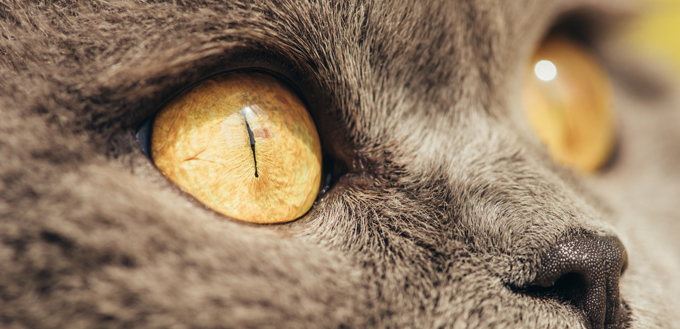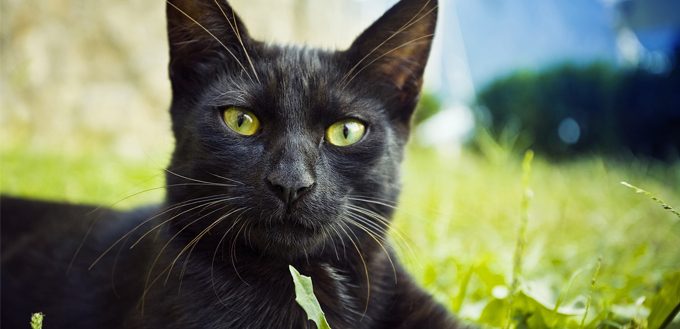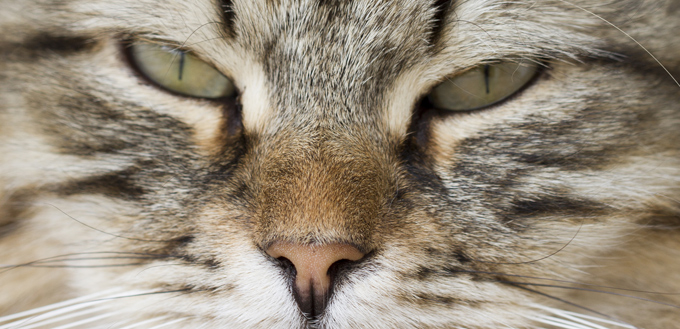Being cousins to some of the world’s foremost predators in the wild and the direct descendants of equally-formidable hunters that prowled the hunting grounds at night, cats have this remarkable ability to see in the dark. And while they don’t have the capability to see in total darkness, their night vision capabilities are far superior to that of any man. Here is everything you need to know about feline vision and their amazing ability to see in the dark.

The Physiology of Vision
Before we get into the nitty-gritty of feline night vision, it is important to have a fair understanding of how the simple process of ‘seeing’ is carried out.
The eyes, whether that of cats or humans or any other living organism with this body part, are generally considered the organs of vision. However, in reality, it is just a component of a complex system of organs that terminate in the brain where all the processing and synthesis of information are performed. In a way, one can always consider the eyes as the principal organs responsible for gathering information that is transmitted to the brain so that the brain can interpret what is being ‘seen’.
This information comes in the form of light. Light enters via the cornea and passes through the aqueous humor before being conveyed into the lens through the pupil. Think of the pupil as the window to the inner structures of the eye. If the window is closed, then light cannot reach the back of the eye. If the pupil is wide open, more light enters. It is, thus, the changes in the diameter of the pupil that the amount of light entering the eyes is regulated. In the dark, the pupils are opened very wide to accommodate more light. In bright light, the pupils constrict to minimize the amount of light that enters the eyes.
Once the light passes through the pupils, it hits the lens and is refracted towards the back of the eye. The function of the lens is to convey refracted light into the retina at the back of the eye where photoreceptors are located. Just like the pupils, the lens can also change its shape to make its focusing power more precise. It is this interaction between the lens and the pupil that facilitates the transmission of light into the retina.
As refracted light hits the retina, photoreceptors are activated. This is one of the main differences between human vision and cat vision. There are two types of photoreceptors present in the retina. Cones are photoreceptors that are more sensitive to colors in the light spectrum. Additionally, they are responsible for seeing during the day. On the other hand, rods are the photoreceptors that are responsible for seeing in the dark as in nighttime conditions. These photoreceptors are more sensitive to brightness levels as well as different shades of gray. They are also useful in peripheral vision.
These photoreceptors convert light information into electrical signals that are transmitted to the thalamus of the brain through the optic nerve. From the thalamus, the electrical impulses are sent to the visual area of the occipital lobe where the impulses are processed into images. These are then sent to the parietal lobe for interpretation.

Differences Between Human Vision and Feline Vision
Based on our understanding of the physiology of vision, there are a few important differences between human and feline vision worth noting. These are important as they can provide the answers to the question “can cats see in total darkness?”
- Cats Have More Rods than Cones
We discussed above that rods and cones are the photoreceptors found in the retina of the eye. Cats have more rods than cones, allowing them to see better in the dark. As a matter of fact, cats will only need about one-sixth the amount of ambient light that humans need to see in the dark. For instance, if humans require 1 lumen to see in the dark, a cat will only need 1/6 of that to see.
As such, to answer the question, ‘can cats see in total darkness?’ the answer is fairly obvious. Since the fundamental requirement to ‘see’ is the presence of light, its absence also prevents vision from ever taking place.
The same is true with kittens. While they do have the same anatomic structure and function as adult cats, one has to understand that the different structures in their young eyes are not yet fully mature. Can kittens see in the dark? Absolutely! However, don’t expect that it will be as effective as the night vision capabilities of adult cats.
- Cats Have a Wider Visual Field
Because cats have more rods and because these photoreceptors are found mostly in the peripheries of the retina, cats have a wider field of vision than humans. On the average, cats can see a wider angle of view of about an amazing 300 degrees while humans can only see a maximum of 180 degrees. Each eye of the cat is capable of seeing 155 to 208 degrees. There is an overlap of about 90 to 130 degrees. This can help improve the night vision capabilities of cats as they are given extended peripheral vision necessary for scanning their environments for both prey and predators.
In addition to their amazing peripheral vision, their eyes are also especially noted for being able to detect and track fast-moving objects. They can detect quick bursts of up to 4 mm per second, allowing them to track and catch fast-moving prey like mice.
- Cats Have Low Vision
While cats have superior night vision capabilities, this doesn’t necessarily translate to visual acuity or the clearness of what they see. A normal healthy person can have a visual acuity of 20/20 which means, if he were to stand some 20 feet away from the Snellen chart, he would clearly see the figures that a normal healthy person can see at the same distance.
Cats, on the other hand, have been shown to have a 20/60 to 20/100 visual acuity. What this means is that they may be 20 feet away from something, yet they will not be able to see it clearly because a normal healthy individual will see it clearly at 60 or even 100 feet. In other words, the images that cats see can be blurry.
Generally, cat fanciers say that majority of cats can see objects from as far as 120 feet away. However, 2 of 5 cats cannot see objects that are within a foot of their feline noses.
- Cats’ Color Vision is the Same as That of a Color-Blind Person
Cats have cones, the photoreceptors responsible for color vision. However, they have less of this in relation to rods. As such, they may still be able to perceive colors but not in the way that humans see them. For instance, they may see different shades of green and blue. However, if they are presented with red or pink, it can be especially confusing as they will look like green. Purple, on the other hand, can be interpreted by the feline brain as just another blue. The same is true with color saturation. It is like turning the saturation of your colored TV to the lowest possible settings.
- Cats Have Tapetum Lucidum
Cats, like dogs, have another important membrane inside their eyes that can help improve their ability to see in the dark. This membrane is called Tapetum Lucidum. It is found at the region of the retina and it serves to reflect more light into the retina. The light it gathers are those that are dispersed within the eye itself as light travels and gets refracted through the different structures of the eye. In other words, the Tapetum Lucidum collects light from within the eyes so that this doesn’t go to waste. It reflects this light into the retina where the rods are located.
One can easily identify the Tapetum Lucidum in cats. This is the characteristic ‘cat’s eye’ seen in the dark. People call it the eyeshine, but in reality, it is the Tapetum Lucidum trying to collect as much light found within the eyes itself and convey it into the retina.
- Cats’ Pupils are Oriented Vertically
Another major difference between human and feline vision is the shape of the pupil. We know that the pupil is the window of the eyes. In humans, this takes on a round shape. In cats, however, the pupil is more elliptical and oriented vertically. When intrinsic eye muscles contract, the pupil opens a lot wider to allow more light to enter. This greatly enhances the ability of cats to see in low light conditions.
On the average, when the cat’s pupils are fully opened, these can be 135 and 300 times larger than a partially-closed or constricted pupil. The pupils of humans can only enlarge up to a maximum of 15 times its constricted size. This large opening allows cats to take in as much light, no matter how faint, as possible and stimulate the photoreceptors found in the eye.

A Cat’s Remarkable Ability to See in the Dark
It should be clear by now how cats can see quite clearly in the dark. Their remarkable ability to see in darkness is made possible by the interplay between a variety of structures in their eyes such as an elliptical pupil, the presence of the super-reflective layer known as Tapetum Lucidum, and the preponderance of rod-type photoreceptors in their retina.
In a dark environment, the cat’s elliptical pupils dilate or increase in size to allow more light to enter. As light enters the various structures of the eye, it is refracted by the lens towards the retina at the back of the eye where the photoreceptors are. Since it is dark or the environment has very low levels of light, the rods become especially sensitized allowing these photoreceptors to convert light energy into electrical nerve impulses that they transmit to the cat’s brain.
Now some of the light entering the eyes may not land squarely on retina. These light waves are reflected by the Tapetum Lucidum back towards the retina so that no light energy is ever wasted. Because rods outnumber cones in the cat’s retina, they are able to gather more of this light energy for conversion into electrical impulses. This leads to the cat’s ability to see in the dark.
Now, can cats see in total darkness? Unfortunately, no. The sense of vision is predicated on the presence of light regardless of how faint or small the light energy can be. In total darkness, there is no light. Even if the pupils of the cat were to open as wide as they can possibly go, there simply is no light energy entering. As such, in the absence of light, no organism can ever truly see.
Can kittens see in the dark, then? A kitten’s ability to see in the dark is dependent on a number of factors. The adult-like functioning of a kitten’s eyes does not occur until the kitten has reached 10 weeks of age. As such, kittens that are younger than 10 weeks are generally considered to have immature visual apparatuses. They may see in the dark, but it may not be as clear or as effective as an adult cat’s night vision capabilities.
There is another side to this physiologic development. The growth and development spurt of kittens occur approximately from 2 weeks to 7 weeks after being born. This means that kittens aged 2 to 7 weeks may already have functioning eyes, but not on a level that is similar to adult cats. On the other side of the equation are kittens that are less than 2 weeks old. The eyes of these kittens are still in the process of being developed so their vision may not be that evident yet.
Cats can see in the dark because of the unique structure of their eyes. It is nature’s way of making sure that they are able to carry out their fundamental role in this world – to hunt.
Check out our latest article: Can Cats See Phone Screens?
Source:
- Dr. Donna Spector DVM, DACVIM, Pet Vision vs. People Vision: Who Sees More?, VetStreet
Note: The advice provided in this post is intended for informational purposes and does not constitute medical advice regarding pets. For an accurate diagnosis of your pet's condition, please make an appointment with your vet.






